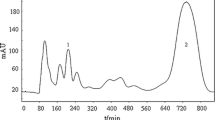Abstract
Separation of potentially bioactive components from foods and plant extracts is one of the main challenges for their study. Centrifugal partition chromatography has been a successful technique for the screening and identification of molecules with bioactive potential, such as steroidal saponins. Agave is a source of steroidal saponins with anticancer potential, though the activity of these compounds in concentrated agave sap has not been yet explored. In this study, fast centrifugal partition chromatography (FCPC) was used coupled with in vitro tests on HT-29 cells as a screening procedure to identify apoptotic saponins from an acetonic extract of concentrated agave sap. The three most bioactive fractions obtained by FCPC at partition coefficients between 0.23 and 0.4 contained steroidal saponins, predominantly magueyoside b. Flow cytometry analysis determined that the fraction rich in kammogenin and manogenin glycosides induced apoptosis, but when gentrogenin and hecogenin glycosides were also found in the fraction, a necrotic effect was observed. In conclusion, this study provides the evidence that steroidal saponins in concentrated agave sap were potential inductors of apoptosis and that it was possible to separate them using fast centrifugal partition chromatography.




Similar content being viewed by others
References
Houghton PJ (2000) Use of small scale bioassays in the discovery of novel drugs from natural sources. Phytother Res 14:419–423
Mbeunkui F, Grace MH, Lategan C, et al. (2011) Isolation and identification of antiplasmodial N-alkylamides from Spilanthes acmella flowers using centrifugal partition chromatography and ESI-IT-TOF-MS. J Chromatogr B 879:1886–1892. doi:10.1016/j.jchromb.2011.05.013
Abdellaoui S, Destandau E, Toribio A, et al. (2010) Bioactive molecules in Kalanchoe pinnata leaves: extraction, purification, and identification. Anal Bioanal Chem 398:1329–1338. doi:10.1007/s00216-010-4047-3
Kim CY, Lee HJ, Lee MK, et al. (2007) One step purification of flavanone glycosides from Poncirus trifoliata by centrifugal partition chromatography. J Sep Sci 30:2693–2697. doi:10.1002/jssc.200700168
Choi S-J, Choi J, Jeon H, et al. (2015) Application of high-performance countercurrent chromatography for the isolation of steroidal saponins from Liriope plathyphylla. J Sep Sci 38:18–24. doi:10.1002/jssc.201401007
Davidson JR, Ortiz de Montellano BR (1983) The antibacterial properties of an Aztec wound remedy. J Ethnopharmacol 8:149–161
Santos-Zea L, Leal-Diaz AM, Cortes-Ceballos E, Gutierrez-Uribe JA (2012) Agave (Agave spp.) and its traditional products as a source of bioactive compounds. Curr Bioact Compd 8:218–231
Ohtsuki T, Koyano T, Kowithayakorn T, et al. (2004) New chlorogenin hexasaccharide isolated from Agave fourcroydes with cytotoxic and cell cycle inhibitory activities. Bioorg Med Chem 12:3841–3845. doi:10.1016/j.bmc.2004.05.004
Yokosuka A, Jitsuno M, Yui S, et al. (2009) Steroidal glycosides from Agave utahensis and their cytotoxic activity. J Nat Prod 72:1399–1404. doi:10.1021/np900168d
Yokosuka A, Mimaki Y (2009) Steroidal saponins from the whole plants of Agave utahensis and their cytotoxic activity. Phytochemistry 70:807–815. doi:10.1016/j.phytochem.2009.02.013
Chen P-Y, Chen C-H, Kuo C-C, et al. (2011) Cytotoxic steroidal saponins from Agave sisalana. Planta Med 77:929–933. doi:10.1055/s-0030-1250672
Yang C-R, Zhang Y, Jacob MR, et al. (2006) Antifungal activity of C-27 steroidal saponins. Antimicrob Agents Chemother 50:1710–1714. doi:10.1128/AAC.50.5.1710-1714.2006
Antunes-Ricardo M, Moreno-García BE, Gutiérrez-Uribe JA, et al. (2014) Induction of apoptosis in colon cancer cells treated with isorhamnetin glycosides from Opuntia ficus-indica pads. Plant Foods Hum Nutr 69:331–336. doi:10.1007/s11130-014-0438-5
Chen PY, Kuo YC, Chen CH, et al. (2009) Isolation and immunomodulatory effect of homoisoflavones and flavones from Agave sisalana Perrine ex Engelm. Molecules 14:1789–1795. doi:10.3390/molecules14051789
Almaraz-Abarca N, Delgado-Alvarado EA, Ávila-Reyes JA, et al. (2013) The phenols of the genus agave (agavaceae). J Biomater Nanobiotechnol 04:9–16. doi:10.4236/jbnb.2013.43A002
Mancilla-Margalli NA, López MG (2002) Generation of Maillard compounds from inulin during the thermal processing of Agave tequilana Weber var. Azul. J Agric Food Chem 50:806–812. doi:10.1021/jf0110295
Santos-Zea L, Leal-Diaz AM, Jacobo-Velázquez DA, et al. (2016) Characterization of concentrated agave saps and storage effects on browning, antioxidant capacity and amino acid content. J Food Compos Anal 45:113–120 http://www.sciencedirect.com/science/article/pii/S0889157515002276
Leal-Díaz AM, Santos-Zea L, Martínez-Escobedo HC, et al. (2015) Effect of Agave americana and A. salmiana ripeness on saponin content from aguamiel (agave sap). J Agric Food Chem 63:3924–3930. doi:10.1021/acs.jafc.5b00883
Gutierrez-Uribe J-A, Serna-Salvdivar S (2013) Agave syrup having anticancer activity. US Patent 8,470,858, June, 2013
Casillas FR, Cardenas AO, Morales CR, et al. (2012) Cytotoxic activity of Agave lechuguilla torr. Afr J Biotechnol 11:12229–12231
Pérez AJ, Calle JM, Simonet AM, et al. (2013) Bioactive steroidal saponins from Agave offoyana flowers. Phytochemistry 95:298–307. doi:10.1016/j.phytochem.2013.06.020
Pérez AJ, Simonet AM, Calle JM, et al. (2014) Phytotoxic steroidal saponins from Agave offoyana leaves. Phytochemistry 105:92–100. doi:10.1016/j.phytochem.2014.05.014
Mimaki Y, Kuroda M, Kameyama A, et al. (1998) Steroidal saponins from the rhizomes of Hosta sieboldii and their cytostatic activity on HL-60 cells. Phytochemistry 48:1361–1369
Mimaki Y, Kanmoto T, Kuroda M, et al. (1995) Steroidal saponins from the underground parts of Hosta longipes and their inhibitory activity on tumor promoter-induced phospholipid metabolism. Chem Pharm Bull (Tokyo) 43:1190–1196
Yokosuka A, Mimaki Y, Kuroda M, Sashida Y (2000) A new steroidal saponin from the leaves of Agave americana. Planta Med 66:393–396
Dávila-Céspedes A, Juárez-Flores BI, Pinos-Rodríguez JM, Aguirre-Rivera JR (2014) Protective effect of Agave salmiana fructans in azoxymethane- induced colon cancer in Wistar rats. Nat Prod Commun 9:1503–1506
Acknowledgments
The authors offer gratitude and acknowledgements to the NutriOmics Research Chair Fund from Centro de Biotecnología FEMSA at Tecnológico de Monterrey, Campus Monterrey and CONACYT (CVU 270166) for financial support for graduate studies and for this research. We are also grateful to AGMEL S.A. de C.V. for providing the concentrated agave sap samples.
Author information
Authors and Affiliations
Corresponding author
Ethics declarations
Conflict of Interest
The authors declare that they have no competing financial interests.
Rights and permissions
About this article
Cite this article
Santos-Zea, L., Fajardo-Ramírez, O.R., Romo-López, I. et al. Fast Centrifugal Partition Chromatography Fractionation of Concentrated Agave (Agave salmiana) Sap to Obtain Saponins with Apoptotic Effect on Colon Cancer Cells. Plant Foods Hum Nutr 71, 57–63 (2016). https://doi.org/10.1007/s11130-015-0525-2
Published:
Issue Date:
DOI: https://doi.org/10.1007/s11130-015-0525-2




